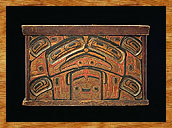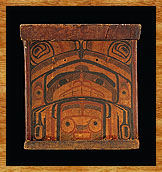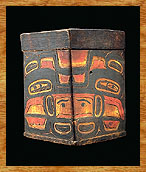(page 2 of 2)
 Boxes and Boxes and
 Chests Chests
 Basketry Basketry
 |
Boxes and Chests
Large bentwood chests, approximately the size of two storage boxes, were favoured by chiefs to store and protect their regalia, particularly their costumes of Chilkat or button blankets, aprons, leggings and frontlets. Important chiefs owned up to half a dozen such chests. The major centres of production for these chests throughout the nineteenth century were at Bella Bella and Fort Simpson. Since Fort Simpson was viewed by all the tribes of the north coast as the hub of trade for expensive goods, including high-quality items of native manufacture, and also had the largest cadre of professional artists throughout the last two-thirds of the nineteenth century, it was probably the source of chests acquired by the Haida, who visited the post annually.

 |
A large bentwood storage chest. The front of the chest portrays the face of Konankada, Chief of the Undersea World. The bas-relief sculpture and incised formlines of the ovoids and eyes represent the highest level of surface decoration achieved by Haida artists.
Collected on Haida Gwaii in 1898 by W. A. Newcombe.
CMC VII-B-129.3 (S92-4193) |

 |
One of the painted end panels of a large bentwood chest. This particular style of chest with carved front and back panels, as well as elaborately painted end panels, was produced by specialized craftsmen at Bella Bella and Fort Simpson.
Collected at Masset in 1898 by Charles F. Newcombe.
CMC VII-B-457.2 (S92-4203) |

The design of the standard chest uses the face of the double-eyed supernatural being on the front panel, while the back portrays the single-eyed being. The sides are often decorated with simple formlines and ovoids, but on a series of chests that were probably imported to Haida Gwaii, the side panels have full designs that resemble the fronts of storage boxes.
After protecting the wealth of a chief during his lifetime, such a chest often became his burial box and the protector of his soul after death.


[ Back view ]
[ Side view ]
|
This exquisite bentwood burial chest is one of the finest in the collection of the Canadian Museum of Civilization. On the front panel, the hands are inlaid with separately carved faces. At each corner, the salmon trout head ovoids indicate the work of an exquisite craftsman. The circles around the eyes of the human face in the lower centre of the panel are the signature feature of an unknown artist whose work was widely traded on the north coast in the mid-nineteenth century.
Collected at Skedans in 1932 by Robert Bruce Inverarity.
CMC VII-B-1881 (S92-4379 front, S92-4381 back, S92-4382 left) |

 |
The back of a bentwood burial chest that has both painted and incised formline designs wrapping around two sides. The ovoids are extremely thick at the top, and the inner ovoids have simple slits indicating closed eyes. Such chests were often found in burial caves, although this example was never used.
Acquired by Charles F. Newcombe in 1898.
CMC VII-B-1559 (S92-4312) |

 |
On this bentwood burial chest, the face of the Beaver crest projects from the front in high relief. It was created, according to Wilson Duff, by Charles Edenshaw during his residence at Port Essington at the mouth of the Skeena. Its form bears a striking resemblance to the sculpted facade of Grizzly Bear's Mouth House at Skidegate, where Edenshaw grew up. Here, however, the design is totally rearranged to be displayed entirely on the front panel rather than being wrapped around all four sides in the usual fashion, a further indication that it was a burial chest meant to be seen only from one perspective. The artist may have intended to use it for his own funeral, but he sold it to another chief instead.
Collected by Harlan I. Smith in 1926 from a chief at the Gitksan village of Kitwanga on the Skeena River.
CMC VII-C-1183 (K84-274) |

|